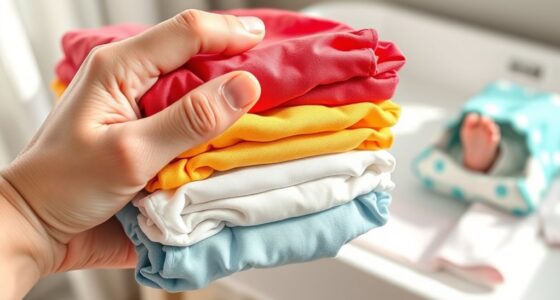To babyproof your home, start by securing the nursery with sturdy furniture and regular safety checks. In the living room, anchor heavy items and block cords and sharp edges. Make the kitchen safe by locking cabinets, covering outlets, and storing hazardous materials out of reach. Protect the bathroom with anti-slip mats and safety locks on doors. Childproof bedrooms and create a designated play area with soft flooring. Confirm safety in utility rooms and perform regular final checks—more tips await to keep your home truly safe.
Key Takeaways
- Secure heavy furniture and install safety gates to prevent falls and unauthorized access between rooms.
- Cover electrical outlets, secure cords, and remove small choking hazards in each room.
- Use safety locks on cabinets, drawers, and appliances to keep hazardous items out of reach.
- Anchor or stabilize furniture and fixtures to prevent tipping or falling accidents.
- Regularly inspect for hazards, ensuring safety devices like monitors, smoke alarms, and locks are functional.
Babyproofing the Nursery

Creating a safe nursery is one of the most important steps in babyproofing your home. Start by selecting sturdy, age-appropriate nursery furniture that can’t tip over easily. Secure heavy furniture like dressers and bookshelves to the wall to prevent accidents. When it comes to baby monitor placement, position it where you can clearly see and hear your baby without cords or wires that could pose a strangulation risk. Keep the monitor away from cribs and bedding to avoid overheating and interference. Make sure the monitor has a secure connection and is out of your baby’s reach to prevent tampering. Regularly check that all nursery furniture is stable and the baby monitor is functioning properly for a safe, comfortable environment. Safety considerations are crucial when choosing and positioning nursery equipment to ensure ongoing protection.
Securing the Living Room
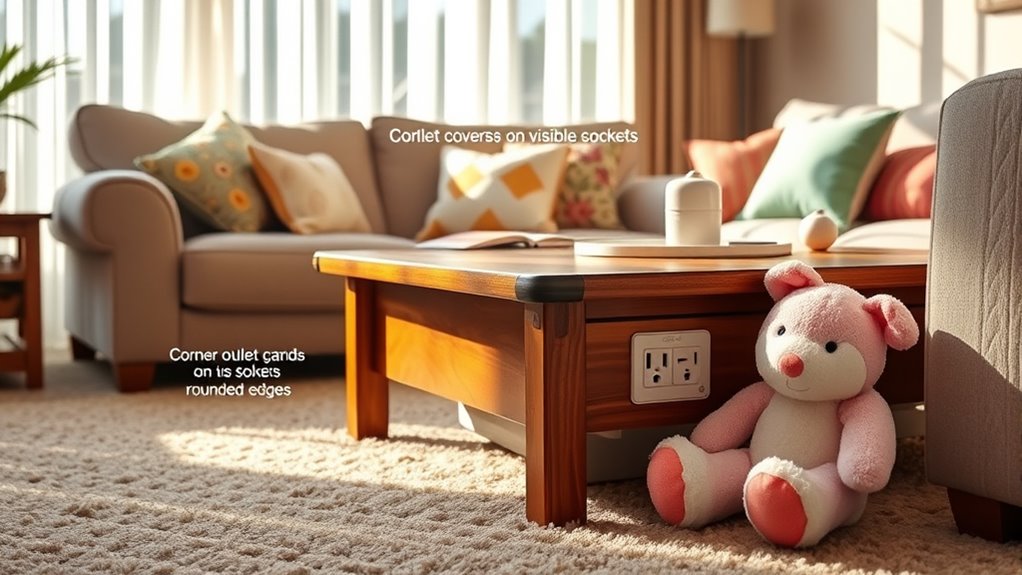
Since the living room is often the main area where your baby will spend time, securing it is essential for their safety. Start by anchoring heavy furniture like bookshelves and entertainment centers to the wall with furniture anchors to prevent tipping. Keep cords from blinds and electronics out of reach to avoid strangulation hazards. If you have a fireplace, install sturdy fireplace guards to prevent accidental burns or falls. Remove or secure small objects that could pose choking hazards, and check that all outlets have safety covers. Keep sharp or breakable items away from your child’s reach. Regularly inspect your living room for hazards, ensuring that everything is stable and secure. Additionally, furniture stability is crucial in preventing accidents, especially when children are active around the space. These steps create a safer environment where your baby can explore freely.
Making the Kitchen Safe
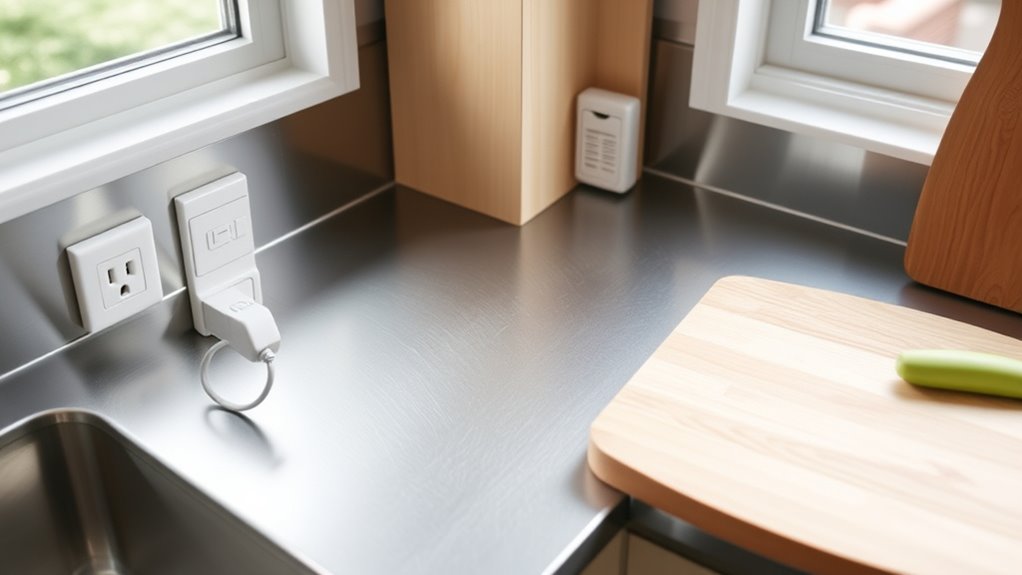
To make your kitchen safer, start by securing sharp items and locking cabinets to keep your little one out of harm’s way. Cover electrical outlets to prevent accidental shocks, and ensure all dangerous tools are out of reach. Taking these simple steps can markedly reduce potential hazards in your busy kitchen. Additionally, using child-safe storage solutions can help keep hazardous items securely stored away.
Secure Sharp Items
Keeping sharp items out of your child’s reach is essential for a safe kitchen. Store knives, scissors, and other sharp tools in high cabinets or use a secure drawer lock. Keep counters clear of cutting utensils to reduce risks. To enhance safety, use fire resistant curtains and non-slip rugs, preventing accidents if your child pulls or trips. Incorporating consistent messaging about safety practices can reinforce good habits for caregivers.
Lock Cabinets Properly
Securing cabinet doors is a straightforward way to prevent your child from accessing potentially dangerous items. Installing reliable cabinet locks guarantees that curious little hands can’t open drawers containing cleaning supplies, sharp tools, or other hazards. Choose child safety locks that are easy for adults to open but difficult for children to figure out. Make sure the locks are compatible with your cabinet types and are securely installed to prevent accidental release. Regularly check the locks for wear and tear, replacing them if they become loose or damaged. Properly locked cabinets give you peace of mind, knowing your child can’t reach unsafe items. Prioritizing cabinet locks is a simple yet essential step in creating a safer environment for your little explorer. Understanding Fokos can help you find additional safety resources and tips to enhance your home’s security.
Cover Electrical Outlets
Electrical outlets pose a considerable safety risk in the kitchen, especially with curious little ones around. To prevent accidents, install outlet covers on all unused electrical outlets. These covers act as a barrier, keeping tiny fingers from poking into sockets and reducing electrical safety hazards. Choose child-proof outlet covers that are easy for adults to remove but secure enough to prevent tampering. Regularly check that covers are in place and in good condition, replacing any that are damaged or missing. Remember, even a moment of distraction can lead to an electrical shock or injury. Additionally, understanding Gold IRA Rollovers can help parents plan for future financial security and stability. By taking this simple step, you markedly lower the risk of electrical accidents in your home, creating a safer environment for your little explorer.
Protecting the Bathroom
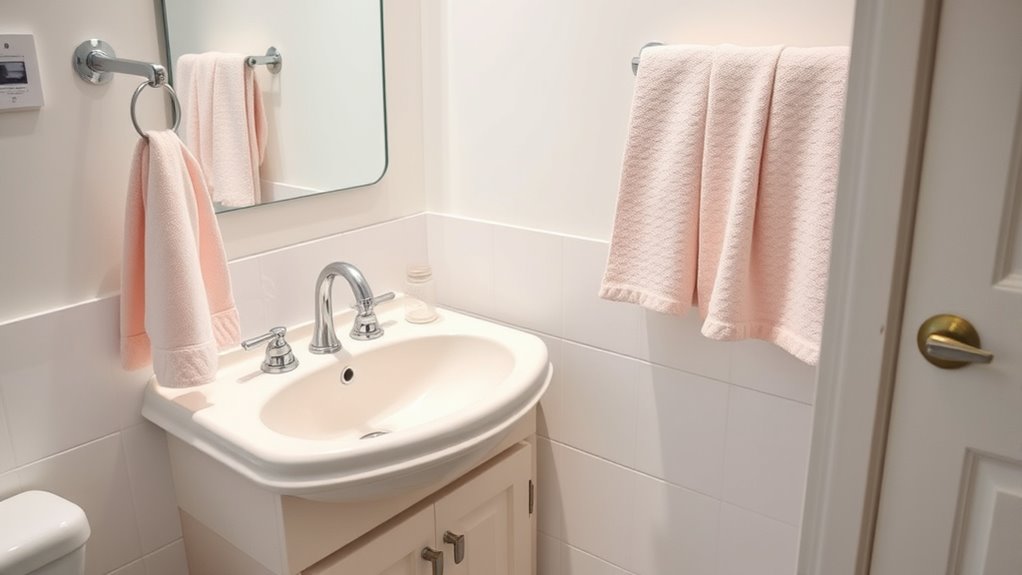
To protect your little one in the bathroom, start by preventing water hazards like slips and scalds. Secure or remove fixtures that can easily be pulled or turned, such as faucets and cabinets. These simple steps keep your child safe while they explore this space.
Preventing Water Hazards
Water hazards in the bathroom pose a significant safety risk for young children, so it’s essential to take proactive steps to prevent accidents. Regularly inspect your water heater for leaks or corrosion, as these can cause unexpected floods. Keep an eye out for plumbing leaks under the sink or around the toilet, fixing them promptly to avoid water pooling on the floor. Ensure all hoses and connections are secure and in good condition. Consider installing pressure relief valves on the water heater to prevent pressure buildup. Always turn off the water supply when not in use for extended periods, especially if you notice any signs of leaks. Being aware of the contrast ratio and other technical aspects of your fixtures can help you identify potential issues before they become hazards. These precautions help minimize water-related risks and create a safer environment for your little one.
Securing Bathroom Fixtures
Have you ever considered how easily bathroom fixtures can become hazards for curious little ones? To ensure their safety, focus on securing bathroom fixtures like the bathtub and faucet. Prevent accidental bumps or drownings by using non-slip mats and keeping water shallow. Install faucet covers to protect your child from sharp edges and hot water burns. Make sure the bathroom door stays closed when not in use to prevent unsupervised access. Check that all fixtures are securely fastened and in good condition. Consider installing a bathtub safety barrier to prevent slips. Keep cleaning supplies and medicines out of reach. Regularly inspect fixtures for stability and wear. Being aware of state-specific laws can also help you stay informed about safety standards and regulations that might affect your home. These steps help reduce accidents and keep bathroom time safe for your little explorer.
Childproofing the Bedrooms

Childproofing the bedrooms is essential to create a safe environment where your little one can explore without unnecessary risks. Start by childproofing furniture—secure heavy dressers and bookshelves to the wall to prevent tipping. Use corner protectors on sharp edges of beds and tables to avoid injuries. Ensure bedroom door safety by installing door locks or door knob covers, preventing your child from entering unsafe areas or trapping themselves. Keep cords from window blinds out of reach and remove small objects that could be choking hazards. Check that electrical outlets are covered with safety plugs. Regularly inspect furniture and fixtures for stability. Incorporating a safety audit into your routine helps identify potential hazards and maintain a secure space. Creating a safe bedroom minimizes accidents and gives your child the freedom to explore confidently within a secure space.
Creating a Safe Play Area
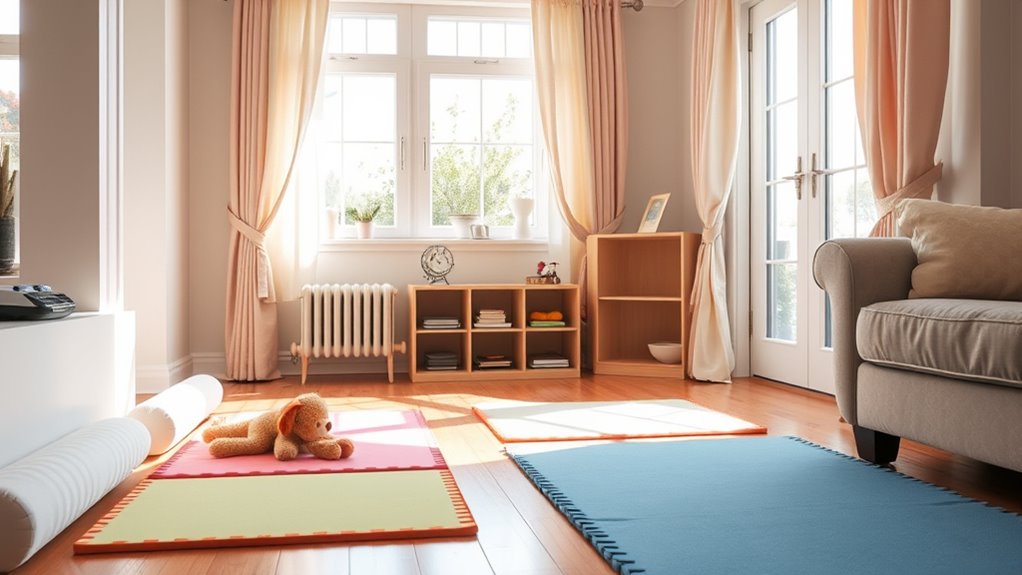
Creating a safe play area is a vital step in ensuring your child can enjoy their time freely without unnecessary risks. Start by choosing a space with soft flooring to cushion falls and reduce injuries. Keep toys organized with accessible toy storage to prevent clutter and tripping hazards. Make sure the area is free from sharp edges, electrical outlets, and choking hazards. Use safety gates if the space connects to other rooms, and supervise your child during playtime. This setup encourages safe exploration and independence while giving you peace of mind. Remember, a well-designed play area promotes fun and safety, helping your little one develop confidence in a secure environment. Prioritize these key elements for a play space that’s both engaging and safe. Incorporating proper ventilation can also improve air quality and help prevent respiratory issues, ensuring a healthier environment for your child.
Safety Measures in the Garage and Utility Rooms
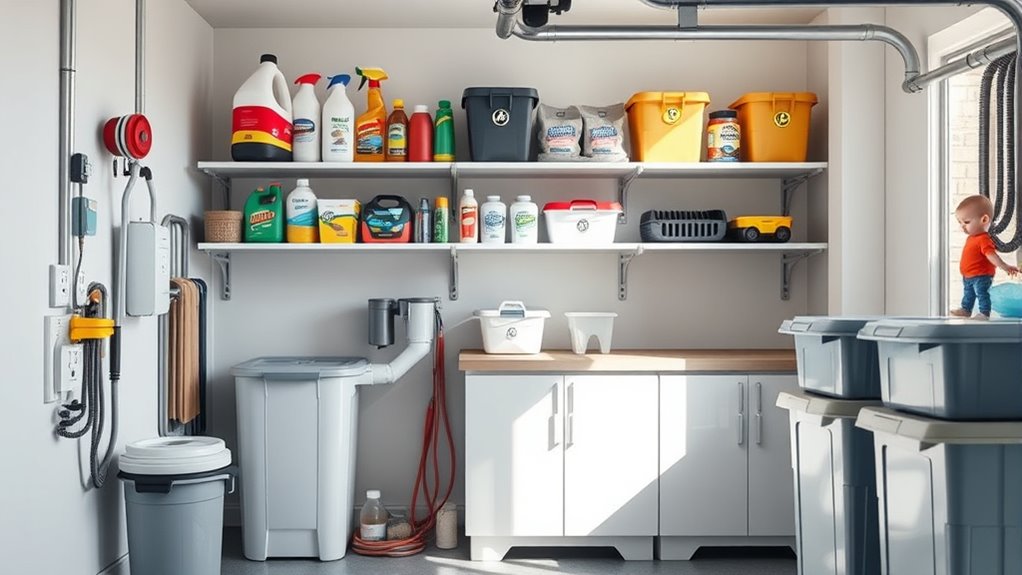
Garages and utility rooms often contain potential hazards that can pose serious risks to your little one, so it’s essential to implement effective safety measures. Start by identifying common garage hazards like sharp tools, chemicals, and heavy objects that can fall. Store dangerous items in locked cabinets or high shelves out of reach. Keep the utility room organized to reduce clutter, which can cause tripping or accidental access to hazardous items. Secure trash cans with childproof lids and unplug appliances when not in use. Cover electrical outlets and ensure cords are out of reach. Regularly inspect for leaks or spills that could cause slips. Additionally, understanding home safety principles can help you develop comprehensive safety strategies. By maintaining proper organization and safety practices, you can prevent accidents and keep your home a safe environment for your child.
Final Checks and Ongoing Safety Tips
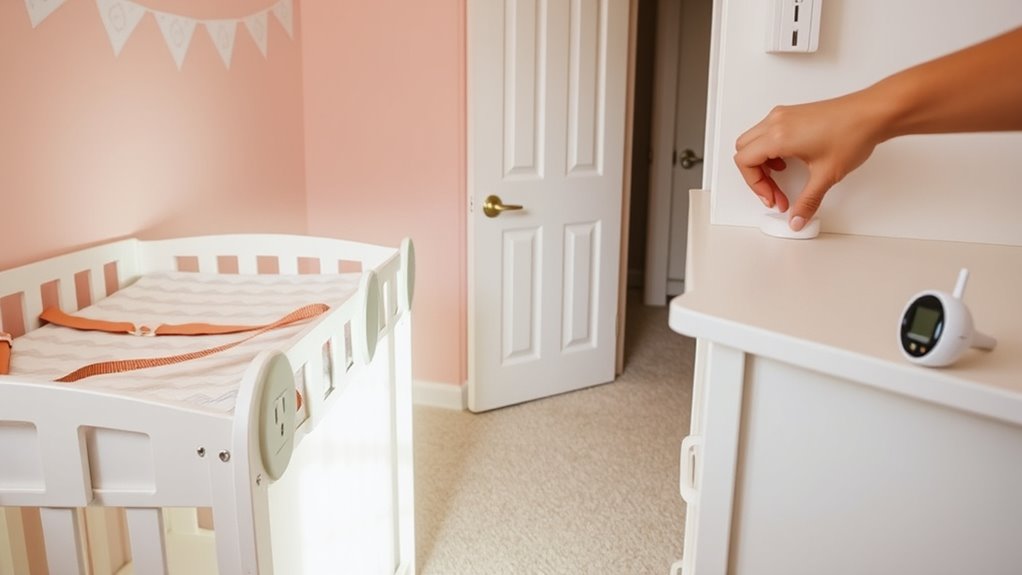
To guarantee your home remains safe over time, it’s important to perform regular safety checks and stay vigilant about potential hazards. Consistently review fire safety measures, like smoke detectors and fire extinguishers, and test them monthly. Keep emergency preparedness plans updated, making sure everyone knows escape routes and emergency contacts. Regularly inspect for hazards such as loose cords or unsecured cabinets. Stay alert to new risks that may arise as your child grows. Incorporating AI advancements can also help monitor safety devices more effectively and provide timely alerts.
Frequently Asked Questions
When Should I Start Babyproofing My Home?
You should start babyproofing your home as soon as you know your baby will be exploring, typically around 3 to 6 months old. Focus on nursery safety and check for electrical hazards to prevent accidents. Early babyproofing helps you identify and fix potential dangers before your little one becomes mobile. By acting early, you create a safer environment, giving you peace of mind while your baby learns to crawl and explore.
How Often Should I Review and Update Safety Measures?
You should review and update safety measures regularly, ideally every few months or whenever your child reaches a new developmental stage. During these checks, focus on fire hazard prevention and electrical safety checks to spot potential dangers. Keep an eye out for new hazards as your child becomes more mobile, and promptly address any issues to keep your home as safe as possible. Staying proactive helps prevent accidents and keeps your little one safe.
Are There Any Specific Safety Products Recommended for Newborns?
For newborns, guarantee your nursery furniture is sturdy and free of sharp edges. Use safety products like crib bumpers, secure window cords, and outlet covers. Always check for choking hazards, such as small toys or loose parts, and keep them out of reach. Regularly inspect furniture and safety devices to maintain a safe environment, adapting as your baby grows and becomes more mobile.
How Can I Childproof Stairs Effectively?
Imagine your little one taking those first wobbly steps—suddenly, danger lurks at every corner. To keep them safe, install sturdy stair gates at the top and bottom of your stairs, ensuring they can’t slip through. Add anti-slip treads to every step to prevent falls, and regularly check these safety features for wear. With these precautions, you create a secure environment where your child can explore confidently.
What Are Common Hazards I Might Overlook in My Home?
You might overlook fire hazards like unattended candles or overloaded outlets, so always keep flames supervised and cords organized. Choking risks are common with small objects, coins, or plastic packaging left within a child’s reach. Regularly check shelves, tables, and floors for these dangers. Keep medicines, cleaning supplies, and sharp tools out of sight. By staying vigilant about these hazards, you guarantee a safer environment for your little one.
Conclusion
By babyproofing each room, you’re creating a safer environment for your little one to explore. Did you know that falls are the leading cause of injury in young children? Regularly check your safety measures and stay vigilant as your baby grows. With these simple steps, you’ll reduce risks and give your child the freedom to discover safely. Remember, a proactive approach today keeps accidents away tomorrow.



